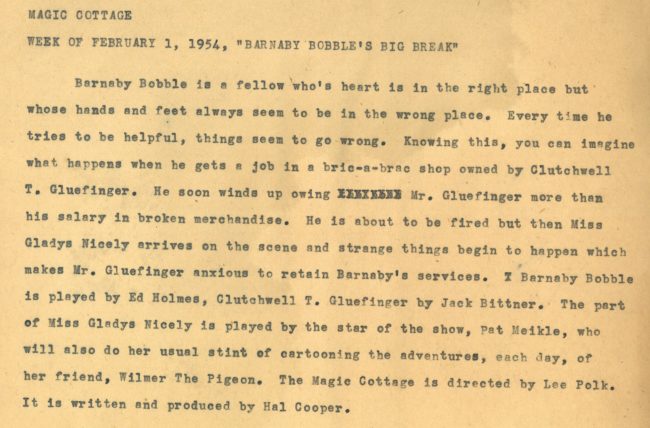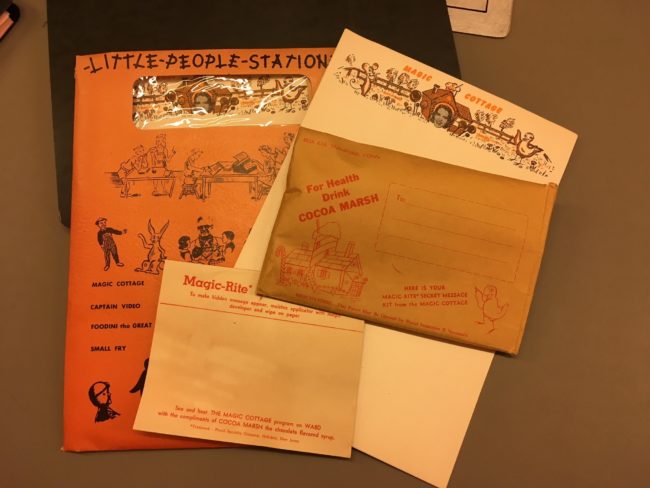The Lone Arranger: Inside The Magic Cottage
In this new blog series, WGF Archivist Hilary Swett gives you a glimpse inside the WGF Archives, from newly unearthed treasures to her tips for preserving a writer's collections. Hello there, boys and girls! In this age of reboots and re-imaginings, what's old is new again. But back in the late 1940s, TV was just beginning and the landscape of shows and genres that we are so familiar with now were just being developed. Children's shows are no exception. We all know the names of the famous shows and possibly grew up watching them—Howdy Doody, Captain Kangaroo, Mister Rogers Neighborhood, Sesame Street, The Electric Company, and more. These friendly adults taught us lessons on how to live and how to get along with one another. One of the earliest examples of this is the subject of today's blog post. Kids visited faraway lands, encountered talking creatures and learned lessons via The Magic Cottage.
Creator Hal Cooper was a prolific television director and worked on every famous sitcom from the 1960s through the 1980s. But before this, he helped solidify a template for TV children’s shows that still exists today. Along with his first wife, Pat Meikle, they were hired by the now defunct DuMont Network to produce a show aimed at preschoolers called Your Television Babysitter. It aired weekday mornings and was intended to give mothers a half hour where they could do housework uninterrupted. This show was such a success that the network asked them to create another show for older kids, which aired during primetime. The Magic Cottage aired on DuMont from 1949-1952 and then locally on WABD in New York from 1953-1955. Pat Meikle hosted the show and all of the episodes were written and produced by Hal Cooper. Each episode began with the almanac segment—a fact from that day in history. Then the fun would start. Meikle would begin by sketching a scene for the audience, and then the characters and fantasy scenarios would be acted out onscreen.

A story was broken up to span the five days of the week and were always fantastic fables and fairy tales, some well-known and some made up for the series. Like shows of today, there would be a moral lesson embedded in the story. This was revealed on Fridays, accompanied by a short song.

In the beginning of TV, everything was performed live, so recordings, also known as kinescopes, are rare. Only two for The Magic Cottage are known to exist: one episode is at the UCLA Film and Television Archive and the other is located at the Paley Center for Media.

Fortunately, Hal Cooper’s family has just donated 1,000 scripts to the WGF Library and Archive. This collection contains scripts for every episode that aired from 1950-1955 when Cooper worked on the show, all of which were written by him. Aside from scripts, the collection contains a small assortment of merchandise created for the show called “premiums.” There are several children’s stationery sets, pins, and “encoded” messages from one of the show’s sponsors, the Cocoa Marsh snack company.
For those of you who want to write for children (or are young at heart), visit and peruse the Magic Cottage Collection to be steeped in fairy tales and get inspired to create your own fairy tale worlds. We have lots of current kids' shows too—just take a look in the catalog! And to hear more anecdotes about the making of these shows, you can watch the Academy of Television Arts and Sciences oral history with Hal Cooper, recorded in 2003.
The Library also has a selection of other scripts for lost TV recordings. Check out:
- My Living Doll - Several teleplays from this 1960s sitcom, including Episode 22, written and shot after the departure of star Bob Cummings
- Major Dell Conway of the Flying Tigers - another DuMont series, from 1951
- Curiosity Shop - A 1970s ABC children's show from creator Chuck Jones (of Looney Tunes fame)
- Meet Millie - a 1950s precursor to Mary Tyler Moore. Only a few episodes survive but we have 113 scripts!
